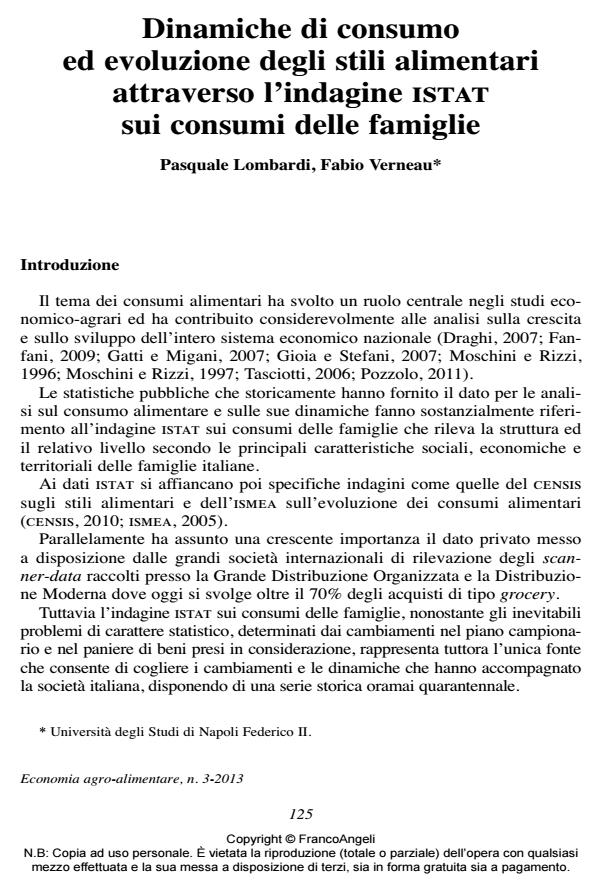Dynamics of consumption and changes in eating habits through the istat survey on household consumption
Journal title ECONOMIA AGRO-ALIMENTARE
Author/s Pasquale Lombardi, Fabio Verneau
Publishing Year 2014 Issue 2013/3
Language Italian Pages 24 P. 125-148 File size 1230 KB
DOI 10.3280/ECAG2013-003008
DOI is like a bar code for intellectual property: to have more infomation
click here
Below, you can see the article first page
If you want to buy this article in PDF format, you can do it, following the instructions to buy download credits

FrancoAngeli is member of Publishers International Linking Association, Inc (PILA), a not-for-profit association which run the CrossRef service enabling links to and from online scholarly content.
The paper uses the 1973-2009 historical series on domestic food consumption, and analyzes the main changes in the structure of food consumption both at national and regional level. In the first part of the work, it is shown the main changes undergone by domestic food consumption basket relative to the eight main product categories consist of: bread and cereals, dairy products and eggs, meat, fishery and fish farming products, fruit vegetables and potatoes, drinks, coffee sugar and groceries, oils and fats. The evolution of the basket is discussed taking into account the main social and economic factors such as the territorial area, the number of members of the family, type of employment. In the second part of the paper the analysis is developed taking into account the regional data. In this case the objective was to compare the differences in the composition of the basket at the beginning and at the end of the observation period to assess how the specific consumption of the 20 Italian regions have developed. By means of a hierarchical cluster analysis, data from three-year periods 1973-75 and 2007-’09 were compared in an attempt to identify the existence of common evolutionary paths in the composition of spending and lifestyles in food. The analysis at regional level suggests the existence of an evolutionary path generating a a process of convergence of the shares of spending on an unique assortment for all regions. This evidence allows to hypothesize the gradual disappearance of the specific regional life style in foods and the birth of a common and strongly homologated style. Although the type of data used does not allow further consideration to analyze the reasons for this convergence, it seems reasonable to identify the pervasive presence of modern retail and widespread role of the media as the most responsible for this process. Finally it is possible to conclude that the disappearance of regional and specific food habits represent a net loss to the country, at least in terms of culture and.
Keywords: Food consumption, evolutionary path, food lifestyle
Jel codes: D120, M370
Pasquale Lombardi, Fabio Verneau, Dinamiche di consumo ed evoluzione degli stili alimentari attraverso l’indagine istat sui consumi delle famiglie in "ECONOMIA AGRO-ALIMENTARE" 3/2013, pp 125-148, DOI: 10.3280/ECAG2013-003008